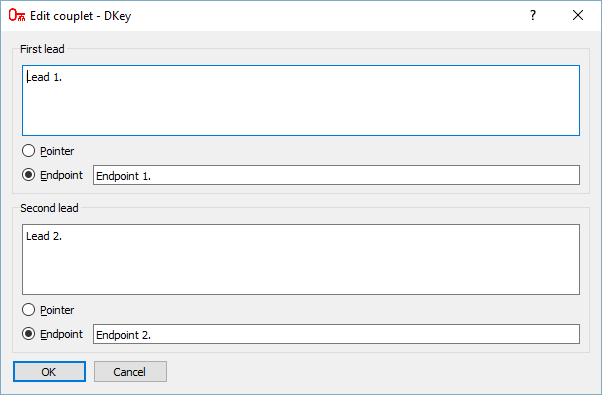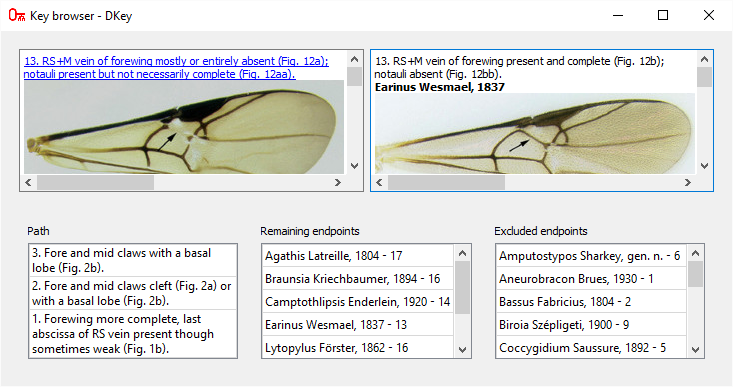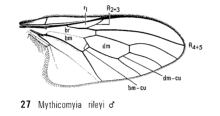
About DKey
DKey software is an editor of dichotomous taxonomic keys. It can be used by taxonomic experts to create keys or by users of printed keys to make them more user friendly. DKey is a free alternative to Lucid Phoenix.
Main features of DKey
- importing existing keys in text format
- combining keys
- moving couplets
- copying couplets
- removing couplets
- renumbering couplets
- making taxonomic keys user friendly
What DKey is not
DKey does not generate the key automatically using data matrix. The key needs to be created by the user.
Dichotomous taxonomic key
Dichotomous taxonomic key consists of a series of consecutively numbered couplets. Each couplet consist of two parts called leads. At the end of each lead there is a reference, which can be either a number pointing to other couplet or a text indicating a name of a species or other taxonomic group. The two types of reference are called here "pointer" and "endpoint", respectively. Pointers are numbers indicating the next couplet and endpoints are taxonomic names obtained at the end of identification process. In front of each couplet there is a couplet label consisting of couplet number followed by number of the previous couplet in parentheses. The couplet number uniquely identifies couplet and it can be used as its address. In a dichotomous key all couplets, except the first, should be addressed by at least one pointer in other couplet, which is indicated by the "number of the previous couplet"
Identification based on dichotomous key starts at couplet number one and it is stepwise. At each step a user reads both leads of a couplet and chooses one of them which better fits the identified individual. If a chosen lead is associated with a pointer then the user goes to the couplet with number indicated by the pointer. The identification is finished when the chosen couplet is associated with an endpoint.
User interface
DKey has a graphical user interface:
The key is displayed in a table with couplets represented by rows. There are three columns: the first column displays couplet number, the second column displays first lead and the third column displays the second lead. The table can be used to edit key by inserting, removing, copying and moving couplets. Content of the couplet can also be changed using Edit couplet.
Image integration
If you want to display images in the key browser ensure that in the key text there is keyword "Fig." before each figure name. Moreover, in the same directory as the .dk.xml file (containing the key) for each image name there need to be an image with the same file name but pre-appended with "fig-". For example, if in a couplet there is text "(Fig. 1a, 1b)", in the same directory there should be two image files: "fig-1a.png" and "fig-1b.png". Apart from providing the image with appropriate image name, the user does not need to make any action to make the images visible in the key browser.
At the moment there are supported two image file extensions ".png" and ".jpg"
Installation
- Download the ZIP file: DKey-2_0.zip
- Unpack the ZIP file and copy DKey directory to your hard drive.
- Run the DKey.exe
At the moment there are executables only for Windows operating system. If you are using macOS or Linux you need to compile the software yourself. The source code is available at: https://github.com/DrawWing/DKey
Please let me know if you have problems with using the software or if you have managed to compile the software for other operating systems.
ChagLog
- 2021-02-02 version 2.0 - undo, redo, fixed bugs
- 2018-10-25 version 1.5 - formatting of text including italic, bold and underline
- 2018-08-18 version 1.4 - added number of previous couplet to couplet label in the exported files
- 2018-02-08 version 1.3 - fixed bugs, error detection for figures, support for [tags], improved navigation
- 2017-12-12 version 1.2 - fixed bugs introduced in version 1.1
- 2017-11-20 version 1.1 - data are saved in XML format
Licence
DKey software is licensed under the GNU General Public License, version 3. That means you are free to download, reuse, modify, and distribute the software under the terms of this licence.
Citation
If you find this software useful please cite it:
Tofilski A (2018) DKey software for editing and browsing dichotomous keys. ZooKeys 735: 131-140. https://doi.org/10.3897/zookeys.735.21412
Help
Video tutorials:
Menu
- Menu File
- Menu Edit
- Undo
- Redo
- Cut
- Copy
- Paste below
- Edit couplet
- Insert couplet below
- Remove couplet
- Swap leads
- Renumber key
- Menu Debug
- Menu View
Menu File
New key
Use this menu entry to creating the first dummy couplet. Select the couplet by clicking it and use Edit couplet to enter real information. In order to add more couplets select the couplet and use Insert couplet below. Finally, save the key using Save.
See also: DKey - getting started
Open
Use this menu entry to open key in ".dk.xml" format. If you do not have your own key yet you can open a key provided with the software in directory "example". If the key is not in ".dk.xml" format you need to use Import.
Import
Use this menu entry to open a key saved in .txt file. If there are special characters they should be encoded in UTF-8. The key can be in various formats including: bracketed and indented, however, the format needs to be consistent in the whole imported key. You need to prepare the file for import. Each lead should be in separate line. There should be a tab character before each reference (endpoint or pointer). For example of indented key see below a fragment of key to genera of Anthomyiida by Elberg (1988).
After editing it should look like this.
Red dots represent spaces and red arrows tab characters. This is a screenshot from Notepad++. I recommend this software for editing text files. In order to make the tab characters visible in Notepad++ use View -> Show Symbol -> Show White Space and TAB.
Only dichotomous keys will be imported properly. If the key is polytomous it should be converted to dichotomous before import. For example of conversion of polytomous key to dichotomous key see below a fragment of key to genera of Agathidinae by Sharkey et al 2009.
The same key fragment after editing
Please notice that before editing there was three leads in couplet number two. In order to make the key compatible with dichotomous key a new couplet was added. In the key there was originally 16 couplets, therefore, the new couplet was given number 17 in order to make the couplet numbers unique. Now the key is not consecutively numbered but this problem can be easily solved after import to DKey using Renumber key.
It is recommended to use Find errors after import. If there are errors it is often easier to edit the imported file and import again instead of editing couplets.
In order to test the import you can use the text file "Sharkey2009Agathidinae-for_import.txt" in directory "example".
Import should also be used to open files in .dk.txt format which was used in the first version of the software.
See also: DKey - import
Append
Use this menu entry to combine two keys. The appended key is added at the end of currently opened one. Only the couplet numbers and pointers are modified in the appended key; the user needs to modify pointers in order to connect the two combined keys in a logical way. Append can be used to transfer couplets between keys; all other editing options (copy, move) can be done only within one key.
Save, Save as
Use those menu entries to save change made in the key to .dk.xml file. It is recomended to save and make new versions of your key often.
Export
Use this menu entry to export the key as text ready for publication or linked hypertext. Export in RTF format does not support text formatting (for example italic). In order to export formatted text to text editor you should use "HTML with tabulators". In this case you should set the tabulators and hanging indent in the text editor. The hypertext in html format can be used to make the key available to others, for example by uploading to web server. In this format user can click links in order to move between couples. The key in html format can be opened with any web browser.
Menu Edit
Undo
Use this menu entry to undo recent unwanted changes.
Redo
The opposite of previous command.
Cut
Use this menu entry to move couplets within one key. The selected couplets will be removed and can be inserted in new position using Paste below.
Copy
Use this menu entry to copy couplets within one key. The selected couplets will be copied and can be inserted in new position using Paste below.
Paste below
Use this menu entry to paste couplets selected earlier using Cut or Copy. Paste operation works only within one key. If you need to transfer couplets between keys use Append instead. After this operation the key usually needs renumbering.
Edit couplet
Use this menu entry to edit a couplet. A small window will appear which can be used to modify content of a couplet.
Instead of using menu you can double click a couplet in order to edit it. When entering the information please notice the difference between pointers and endpoints. If the edited lead refers to another couplet choose "Pointer" and enter the number of the other couplet in the provided spin box and do not enter the number as "Endpoint".
In order to format the text select a fragment and use context menu (under right click). You can also use shortcuts: Ctrl+I, Ctrl+B and Ctrl+U for italic, bold or underline, respectively. You can also copy and paste text in other formats including font colour, however, this is not recommended. In general the formatting should be avoided and italic should be used for Latin names only.
Insert couplet below
Use this menu entry to insert dummy couplet. Select the couplet by clicking it and use Edit couplet to enter real information. After this operation the key usually needs renumbering.
Remove couplet
Use this menu entry to remove a couplet. After this operation the key usually needs renumbering.
Swap leads
Use this menu entry to replace the first lead with the second lead and vice versa.
Renumber key
Use this menu entry to make the couplet's numbers consecutive. The pointers are changed accordingly in order to maintain integrity of the key. When couplets are inserted, removed, moved or copied the key is not renumbered automatically and its consecutive numbering can be temporally broken. The user decides when the renumbering occurs. This make it easier to keep track of changes made. Moreover, the renumbering can take a noticeable time in case of large keys. Therefore, in case of several editing operations it is better to make one renumbering when all the editing is finished. The renumbering should be done before the key is exported or displayed in the key browser.
Menu Debug
Find errors
Use this menu entry to check the key for presence of errors. Among others it is verified if the numbering is unique and consecutive. The errors are listed in separate window.
Menu View
Key browser
Use this menu entry to see a new window with the key browser.
Key browser consist of five windows. The two top windows contain the two leads of the couplet and images associated with the leads. If a lead is associated with a pointer there is a link to the pointed couplet. By clicking the link user goes to the pointed couplet.
The three bottom windows of the key browser contain: path, remaining endpoints and excluded endpoints. The path or history of identification contains list of couplets leading to the current couplet. The remaining endpoints contains list of taxa which can be reached from the current couplet. The excluded endpoints contains list of taxa which cannot be reached from the current couplet. At the beginning of identification, when couplet number one is displayed, the path window and excluded endpoints window are empty, on the other hand the remaining endpoints window contains all the taxa covered by the key. By following steps of the identification and visiting couplets the lists in path window and excluded endpoints window are growing and the list in remaining endpoints window is shrinking until there is only two endpoints.
Hypertext in table
Use this menu entry to see a new window with the key in format of linked hypertext.
If a lead is associated with a pointer there is a link to the pointed couplet. By clicking the link user goes to the pointed couplet.





